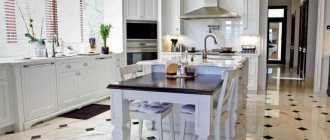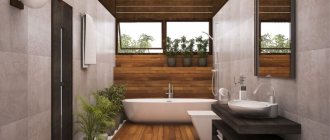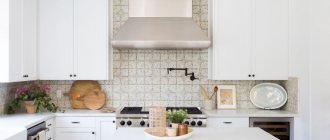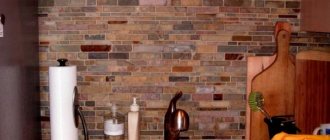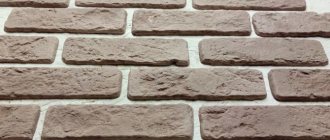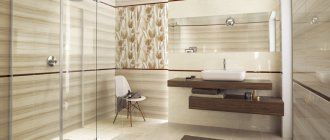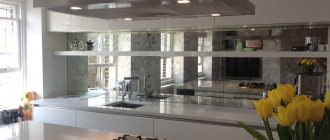Floor tiles are a combination of functionality and aesthetics. Find out from us what is best to put in the kitchen, in the living room, and what on the floor in the bathroom. Our quick guide will show you which floor tiles are worth your consideration.
What you will read about in the article:
- Flooring in the house - properties and use of different types of tiles
- Is terracotta on the balcony the best choice?
- Clinker tiles in the kitchen - functional design
- Gres tiles - practical bathroom decoration
- Marble in the living room - classic in a luxurious version
- Granite tiles in the hallway - a solution that you will appreciate
What you need to lay floor tiles
Just three things:
- Floor tiles;
- Glue for installation and grout for seams;
- Tool.
And, of course, your desire. But in order to choose the right material, which is not only beautiful to look at, but also most suitable for operating conditions, you should immediately talk about its characteristics.
All tiles differ in size, color and patterns, physical properties and other components that characterize the area of its application.
Selection of adhesive mixture
Compositions for gluing floor tiles can be purchased dry or ready-made. Bulk mixtures require subsequent dilution with water right before laying the material. They are sold in bags and packages. You need to prepare glue at home according to the instructions, strictly observing the proportions. The advantage of using dry mass is the ability to dilute only the required amount of substance for installation, and an affordable price.
Ready-made mixtures are produced in plastic buckets or canisters. They are ready for application and begin to harden upon contact with air. Due to their high cost, they are purchased only if it is necessary to lay tiles over a small area, for repair work on an already finished coating. With certain skills, any adhesive mixture can be replaced with cement-sand mortar.
What you need to know about tiles
The main requirements for the entire tile series are:
- Frost resistance;
- Water absorption;
- Wear resistance (IV class);
- Resistance to chemically active substances;
- Fire resistance and fire resistance;
- Slip resistance.
Here are several criteria by which floor tiles should be selected for different rooms.
- Kitchen floor tiles. The floor in this room is constantly exposed to frequent contact with grease and oils. Therefore, it requires tiles with increased resistance to detergents. Plus, quite frequent visits to the kitchen by a person require a high wear resistance class of tiles (not lower than III).
- Floor tiles for the hallway. Darker tones of colors are desirable, because dirt on them is not so noticeable. In addition, the floor of this room will constantly be exposed to shoe soles and heels of women's shoes. Cases of exposure to heavy objects brought in from the street, for example, suitcases with metal legs, children's sleds, etc. are also not uncommon. Therefore, the degree of wear resistance of the coating must be at least class III.
- Bathroom floor tiles. Constant high humidity forces bathroom tiles to be laid in a manner that has a low degree of moisture absorption. Its textured surface will also be important, allowing it to provide good slip resistance.
Grade
In Russia, since the times of the Soviet Union, finishing materials have been divided into grades. Products of the first (highest) grade do not contain any debris or stains on the surface of the coating.
Defects in the product or coating are not noticeable from 1 meter. In products of the second grade, stains, chips and other defects are possible, provided that they are not noticeable from two meters. The cheapest floor tiles are third grade. Allows a large number of defects. Currently extremely rare.
Typically, varieties are color coded on the packaging. For the first - red, for the second - blue and green, respectively - for the third. A batch of first grade tiles contains more than 95% quality products. A Grade 2 lot may contain a minimum of 5% damaged or defective tiles.
Porcelain tiles for the kitchen
In addition, there is such a type of floor tile as porcelain stoneware. In its mechanical properties and appearance, it is very similar to natural granite.
In terms of wear resistance it has V, the highest class. With its help, both indoor floors can be perfectly decorated, tiles can be laid on steps outside the house, and the surfaces of open balconies and terraces can be tiled.
Tile adhesive
As has already become clear from the above, each tile has its own purpose. Therefore, the materials for its flooring must be suitable. Different manufacturers call adhesives differently.
Therefore, it is customary to roughly divide them into three types:
- Primary. Perfect for wall tiles and small floor tiles located in dry rooms;
- Reinforced. Used for laying large-format floor tiles and small porcelain tiles. Has a high degree of moisture resistance;
- For difficult surfaces. Designed for installation of any porcelain tile on concrete bases, old tiles and even glass. It can also be used for laying natural stone on the outside of a building or covering car showroom floor surfaces. Very durable. Not afraid of either moisture or frost.
Important! If floor tiles are being installed on a previous surface or on a surface with a large number of joints, then the top tiles should overlap the old seams.
Fashionable items
Warm carpet tiles cover the floors in the nursery and bedroom. The width of the square is 50 cm. This is a multilayer product with layers of reinforced material. The tiles are rigid and do not deform. Bitumen, polyvinyl chloride, fiberglass or rubber are used for the base. The top layer constantly attracts dust, so daily cleaning is required.
More: Reliable solid wood flooring
New products include expensive leather tiles. Suitable for ethnic, colonial and art deco styles. The base of the tile is porcelain stoneware, and the top is impregnated calfskin.
The original “living” 3D tile - a multilayer product made of polycarbonate materials with a gel filler - cannot be cut or bent. Do not load more than 40% of the area. As you move across the floor, the pattern and color of the picture changes.
Marking
Having decided on the materials and adhesive mixtures, you can begin marking the room. But first you need to determine how to lay floor tiles in order to accurately calculate the required quantity.
The easiest option is to first draw everything on a piece of paper. It is best to use a computer layout program. Now there are many of them.
After purchase, it is recommended to lay at least part of the tiles “dry” on the floor and visually look at the result. You may need to adjust (move in one direction or another) the location.
Important! The tile is highly durable, but at the same time fragile. Therefore, it is recommended to buy it with a margin of 10-15%.
Marble in the living room - classic in a luxurious version
Marble has been a symbol of prosperity and luxury for centuries. This would be perfect for the living room floor! Thanks to this you will get a classic and modern interior. High gloss and unique patterns make marble in the living room the pinnacle of elegance. Every day he will again and again evoke the admiration of family members and the admiration of guests.
Marble is also resistant to high temperatures - at the same time, it conducts heat very well and retains it for a long time. This is why it is the ideal solution for underfloor heating.
However, remember that this unique stone requires special processing. To lay marble on the floor, you need to use special preparations, including glue and waterproofing. Thanks to this, the absorbent rock will increase its resistance to moisture and staining. Annual maintenance is a worthwhile investment that will ensure you enjoy the luxury of your living room for a long time to come.
Tile composition
If you plan to decorate a large room, you can create geometric shapes using different shades of tiles. Existing “borders” for tiles will help add contrast to monochromatic coverings or create zoning of an area.
There are even entire floor panels consisting of 4, 8, 9, 16 or more tiles with printed images.
In general, there are many decor options. It all depends on the availability of a good hardware store nearby, your own imagination and financial capabilities.
Options for laying tiles in the kitchen
You should also decide on the flooring technique. Today there are two rules for laying tiles. Namely:
- Seamless;
- With seam.
Seamless technology has appeared relatively recently. But despite this it has already gained popularity. The surface obtained in this way creates the effect of a certain solidity of the entire floor. But this option is not very easy for beginners.
- Firstly, in order for the floor to look impeccable, you need extremely smooth tiles with the correct geometry. Most of its cheap types, and sometimes some of the expensive ones, are guilty of this. Therefore, before laying, you should go through all the material and sort it by size. Otherwise, it will be impossible to hide flaws.
- Secondly, in the event of any even minor peeling, the resulting surface will begin to deteriorate very quickly. This method of flooring is best left to an experienced craftsman.
The suture technique has been used for quite a long time and is well known to everyone. In this case, there is a distance between the two mating tiles. As a rule, this is 1-3 millimeters.
To ensure that the seams are the same size, special crosses are used when laying. After the adhesive has dried, they are removed and the gaps are filled with a special tile grout.
Laying tiles diagonally
Options for laying floor tiles with a seam are divided according to the installation method.
There are three main ones:
- Seam to seam;
- In the dressing;
- Diagonally.
- The first one can be called classic. The tiles form rows in horizontal and vertical directions.
- The second involves pairing the tiles like a “brickwork” bond.
- And with the third, seams are formed in diagonal directions at an angle of 45 degrees relative to the walls.
Useful tips from experts
When choosing a material, you must carefully study the characteristics of each type of tile. They must meet the needs of the owners. It is necessary to take into account the degree of strength, thickness, and the need for a glazed coating.
The texture of floor tiles should be moderate. Slight ribbing will prevent slipping. If the patterns and grooves protrude too much, this may make cleaning difficult. The gloss will highlight even the slightest dirt.
It is better to dilute the adhesive composition for installing tiles in small portions. If unforeseen circumstances arise and the installation process slows down, it will not be able to dry. Only cold water is used for mixing. Hot liquid will deteriorate the quality of the adhesive solution.
The material can only be laid on a flat, clean floor; door frames and baseboards must be removed. It's easier to work along guide lines. The resulting gap between the outer row of tiles and the wall can be hidden with a plinth or you will have to glue a ceramic strip.
Tools
To lay tiles, regardless of the base, mixtures used to level the floor, methods, adhesive tile compositions and other components, you will need a certain set of tools. Here he is:
- Flute brushes and paint brushes - for cleaning the surface for laying. You can also use a construction vacuum cleaner;
- Paint roller – for priming the floor;
- Tape measure, square, ruler - measuring tools. Will be needed all the time until the end of the flooring;
- Hydraulic level, tapping cord - will serve at the stage of marking the surface for laying;
- Rule-trapezoid, level, nylon thread - necessary to create precise horizontal lines and prevent differences in floor level;
- A drill with a mixing attachment and a deep container - you cannot do without their help when preparing the adhesive mixture;
- Spatula, notched trowel, trowel - tools for applying diluted mortar to the surface of tiles and floors;
- A rubber hammer is a tool for shrinking the laid tiles;
- Tile cutter, tile cutter, grinder with a disk for dry cutting - specific tile tools for cutting tiles in straight lines;
- Tile nippers - will be needed in case of removing small pieces of tiles (in particular corners) of irregular geometric shape;
- Ballerina is a tool for drilling even round holes of various diameters.
- Grouting compounds
Design ideas
Having discussed the technical characteristics, you can smoothly move on to the external design. It’s not without reason that they say that the hallway tells the story of the house itself. Every detail in the tile affects the impression.
Shades
Light tiles visually expand the space in the room. For these purposes, beige and walnut shades are used. Pastel colors are suitable. However, such a background gets dirty easily, so you will have to clean it more often.
- The dark shade of the floor draws attention to minimal scratches.
- The smooth surface of black tiles also gets dirty periodically.
- A darkened color scheme visually makes the room smaller, which should not be allowed in a small hallway.
- To visually expand the room and harmoniously decorate the interior, muted shades are recommended.
- Tile patterns act as an accent so that the interior does not seem so boring.
The tone deserves attention. Objects of a cold shade visually move away, and in warm colors the effect of proximity is triggered.
Patterns
Correctly placed tiles in a secluded room transform the room. Some techniques are used to make everything beautiful: original patterns and geometric shapes are selected.
The flooring is decorated with small patterns, which has a positive effect on the home atmosphere. However, designers often combine it with a plain base to achieve harmony in the interior.
Grouting tile joints
With the help of grouting compounds, the laid tiles acquire a finished look. With their help you can create an excellent contrast to the tiled surface.
It should be noted that in addition to the decorative function, the grout also has a very practical purpose - it protects concrete screeds or wooden floors under the tiles from moisture from the environment.
Today, the two most common types of such fillers are:
- Cement based;
- Based on resins (mainly epoxy).
- The first, in addition to cement, contain additives that increase ductility and water resistance. May contain coloring pigments. Designed for filling joints indoors. They are relatively inexpensive.
- The latter are usually two-component. They consist of resin and hardener itself, which, when hardened, form a very durable moisture-proof surface. They are used for grouting joints in all types of premises and even swimming pools.
It is also important that they resist temperature changes very well. Do not react to chemically active substances.
The only downside is the difficulty of working with them due to their viscosity and the difficulty of cleaning the tiles if they are applied incorrectly.
Laying floor tiles is a long and labor-intensive process. It has its own laws, specifics and rules. But if they are followed correctly and completely, the expected end result will certainly be achieved.
Step-by-step instruction
When laying tiles on the floor, it is important to properly prepare the base, since tiles on an uneven surface will “walk” a lot, this spoils the appearance of the coating and can be felt when walking. Another challenge when finishing flooring is creating the same level in all rooms.
Let's consider the general order of work:
- Floor leveling (screed, self-leveling floors).
- Leveling walls (plaster or drywall).
- Laying tiles on the wall from the second row, leaving the first unfilled.
- Laying tiles on the floor.
- Laying the first row of wall tiles.
We discussed in detail the reason for this order of work when laying tiles in the article about laying tiles on a wall in a bathroom.
Required Tools
- Spatula with a smooth edge
- Spatula-comb
- Rubber grout spatula
- Laser or water level
- Bubble level
- Crosses or tile leveling systems (SVP)
- Rubber hammer
- Containers of different sizes for mixing tile adhesive, cement-sand mixture and grout
- Rule
- Drill mixer
- Roller with a long handle for distributing the primer
- Brush for priming individual areas
- Tile cutter
- Ceramic nippers
- Roulette
- Construction square
It is advisable to use a separate container for each type of knitting. For grouting, a small tray will be enough so that the mixture does not come into contact with the remains of the cement composition.
Required building materials
- Tile
- Tile adhesive
- Cement-sand mixture for screed
- Steel profiles for lighthouses
- Primers depending on the type of surface
To seal seams and cracks in the base, putty or foam may be required.
Step 1: Level the surface
It is advisable to lay the tiles on a flat surface, since distortions will lead to increased consumption of tile adhesive. In addition, the differences will be visually noticeable.
Leveling can be done in different ways: wet, dry, semi-dry screed or using a self-leveling floor. Differences in the level of the foundation in new buildings can range from 3 to 20 cm, the average is 7 cm. This means that at the lowest point of the apartment there will be 7 cm, and at the highest - at least 3 mm, if a cement-sand screed is used.
The most universal is “wet” leveling with cement-sand mortar; we will consider this method in the article.
- At the first stage, you need to prepare the room for work: remove all debris, collect fine dust with a construction vacuum cleaner.
- We check the floor surface for differences. This information will be needed to set up beacons, which must be on the same level.
- Usually the floors in all rooms are brought to the same level, so it is necessary to find the zero point.
The zero point is the highest point of the floor in a separate room or in the entire apartment. It all depends on whether it is necessary to make the base level the same in all rooms. At the zero point the screed will be thinnest.
- We set a horizontal line on all the walls of the room with a laser fender builder. The distance to the floor is usually taken equal to an integer (10 cm, 50 cm, 1 m) to make it easier to count, but the specific value does not matter when setting up the device for the first time.
- We apply the beginning of the tape measure to the floor and measure the distance to the beam in different corners of the rooms. If we move the device to other rooms, then we take the height that was used initially. For convenience, you can mark the walls using a marker. The place where the height is minimal is considered the zero value.
- We add the thickness of the screed to the minimum distance to the beam (3 cm, 5 cm - with warm floors). At this stage, we need to mark on the square the height from the tie to the beam on the construction square. If initially the distance from zero to horizontal was 10 cm, then raise the level by 13 cm, and mark 10 cm on the square.
- To check the calculations in practice, you can put a small block on the floor, which will represent a screed. To increase the height, we screw a self-tapping screw into it and attach a corner to it. In order not to spoil the tool with marks, we glue masking tape on it and make a mark at the level of the beam height.
- Before installing the beacons, seams, joints and cracks in the floor are sealed. You can lay a plastic film on the base to prevent moisture from leaking from the solution to the lower floors. Sometimes sound insulation is placed in the screed, then the thickness of the floor needs to be increased. We take these numbers into account in our calculations.
If the apartment has already been laid with tiles in separate rooms, then the thickness needs to be taken into account (usually it is 1.1 - 1.7 cm). The size of the tile adhesive layer depends on the size of the tooth on the trowel-comb.
- Now you can start installing beacons. For a screed 3 cm thick, it is recommended to use a profile 1 cm high. The beacons are placed on flats of plastic mortar, the joints are laid with a slight overlap so that when leveling the rule does not cling to the joint.
On the street and in areas of high humidity, it is better not to combine a gypsum mixture with a cement mixture, since contact of their components with water leads to a chemical reaction - the formation of ettringite.
- The distance between the beacons must correspond to the length of the rule. We place a construction corner on the profile at the most protruding point and press it into the solution until the mark on the masking tape coincides with the beam of the axle builder.
- We carry out this procedure on all areas of the floor until the mark on the corner coincides with the horizontal line of the laser.
- When the beacons are on the same level, you can secure them. To do this, we lubricate the voids under it with a solution.
- Now you can begin leveling; the voids between the profiles are filled with mortar. The rule is to trim off excess mortar. A wet screed gains 100% strength in 28 days, 70% - under normal temperature and humidity conditions - is achieved after 7 days. Most craftsmen believe that after this period you can move on to subsequent finishing.
Read more about pouring wet screed in a separate article on our website.
Laying floor tiles depends on differences in the walls. If the corners are not 90 degrees, then the tiles will need to be trimmed in these places.
Step 2: Marking for the layout diagram
Before laying tiles, it is important to estimate the location of the elements on the surface. This can be done on paper or marked on the floor. The layout performs two tasks: to minimize trimming and determine the location of the seams. The appearance of the floor depends on the installation method; here are examples of layouts.
- Traditional (classical) is the most universal method, well suited for any room and easy to perform for beginners. The tiles can be either rectangular or square. With this method, the seams go without displacement.
- Diagonal can only be used with square tiles. This method increases the number of scraps. The tiles near the walls have the shape of a triangle, and it is desirable that the size of these pieces be the same on all sides.
- Offset - can be diagonal or perpendicular to the walls. The seam in this case is similar to that of brickwork. This method requires a rectangular tile.
- “Herringbone” - this installation method imitates parquet. The layout is difficult for beginner tilers and requires a lot of experience.
When laying out floor tiles, it is important to consider the location of decorative elements. They are usually more expensive than background tiles, so you need to place them in a visible place. There is no point in putting them under the bathtub or stove, since no one will see them there. It is better to lay solid tiles at the entrance to the room; cut pieces can be laid in the far corners.
Before starting work, it is useful to lay the tiles on the floor. The layout can start from the most visible corner or from the visual center of the room.
Step 3: Preparing Tile Adhesive
Tile adhesive should be selected depending on the temperature and humidity conditions of the premises. In wet areas, it is better to give preference to compounds with low water absorption.
Before preparing the glue, it is recommended to read the instructions on the package. Each glue has its own marking according to the state standard. We wrote about changes in GOST for tile adhesive in a separate article.
- For mixing, you need a clean container without any remnants of old solutions.
- You need to add water to the container, and then add the dry ingredients. This procedure is necessary to prevent the formation of lumps.
Tile adhesive does not require the addition of any additional ingredients.
- The solution is mixed with a spatula or drill mixer. The nozzle must be clean, traces of old mixtures must be cleaned.
- After this, the glue is left for 10 - 15 minutes to saturate with moisture, then mixed again. You need to achieve the consistency of thick sour cream.
Insertion: Before the main work, you need to prime the surface. We discussed the choice of composition in detail in the article about laying tiles on the walls in the bathroom .
Step 4: Apply Adhesive to Tile or Floor
The glue can be applied in three ways. To do this you will need a spatula with a smooth edge and a comb.
- Application on the back side of the tile
- Floor application
- Application on both surfaces
There is no fundamental difference between the first two methods. The first increases the pace of work, but is suitable for more experienced tilers. The third application method is used when the surface has unevenness, which requires increasing the thickness of the binder.
Previously, the tiles and surface were moistened with water. This was done to prevent the ceramics and screed from drawing water out of the glue. Modern binders and primers prevent moisture absorption, so additional moisture is not required. Read more about mistakes when laying tiles in a separate article.
The glue should be evenly distributed over the surface of the tile, avoiding furrows in an arc. The comb should move horizontally or vertically. If the composition is applied to the wall and ceramics, then the directions alternate.
There should be no voids left between the tiles and the floor, otherwise a piece of ceramic will break off under mechanical load from above. Most often, such a defect makes itself felt when chips and cracks appear at the corners when hard objects fall.
Step 5: Laying the Tile
- After applying the mortar, move the first tile along the layout. First we lay only the whole tile, the cut one is glued at the end.
- To seat the tiles onto the mortar, use a rubber hammer. If the tile has a fragile decorative coating, then tapping can be done by hand.
- We check ourselves by applying the bubble level in different directions.
- We insert crosses or SVP (tile leveling systems) into the seams so that the size of the gaps is the same everywhere.
SVP: wedge with clamp
For beginners, it is preferable to use leveling systems because they not only allow you to maintain the size of the seam, but also fix the same height of the tiles.
Step 6: Trimming the Tile
To cut ceramics, you can use a tile cutter, grinder, glass cutter, sharp sharpened drill, or ceramic nippers. The choice of tool is individual, but the easiest option for a beginner is a tile cutter.
- Mark the cutting line on the tile and place it on the platform. The mark should align with the marks on the tool.
- An incision is made with the handle on the roller, then one half of the tile is broken off by pressing the lever.
When making a diagonal cut, it is better to make the break by hand, and the arc-shaped element is made with ceramic nippers. Read about other methods of cutting tiles in a separate article on the website.
Step 7: Grouting
The grout (fugu) is applied after the glue has hardened; this process usually takes a day, but before this point it is important to have time to complete several operations.
- The tiles must be washed; if the glue dries on the surface of the tiles, it will be difficult to remove. At the same time, fresh masonry can be moved, so you should not work with a sponge before the initial setting.
- While the glue has not yet hardened, you need to unstitch the seams. To do this, part of the solution is removed from them. This place will be occupied by a fugue in the future.
Read more about mistakes when grouting tiles in a separate article.
- Fugu is prepared from a dry mixture in small portions. To do this, you need to take a clean tray. It is not recommended to mix the composition with a drill, as too much air will get into it. For this purpose it is better to use a rubber or steel spatula.
- It is better to apply the fugue with a soft rubber tool, because metal can leave damage on the tile.
- After rubbing the mixture into the joints, the remaining fugue must be washed off the tiles with a sponge and a colorless detergent.

